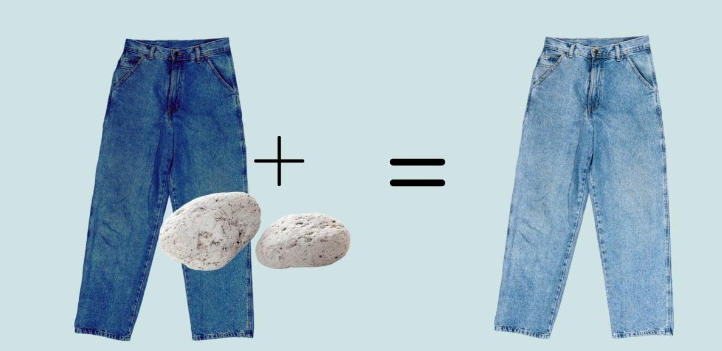Stone washing which gives denim a faded, vintage appearance is a revered technique, that has undergone a significant evolution over the years marked by both traditional practices and modern innovations. This technique which was first developed to soften and distress jeans, has changed over time incorporating both conventional and cutting-edge techniques. In addition to its aesthetic appeal, there is a growing emphasizes on sustainable practices within the textile industry. This article emphasizes on the environmental impacts and highlights new, environment friendly solutions.
Stone wash process:
The textile washing process is a process that imparts a faded, worn-in appearance to fabrics and has a long history that dates back to the early days of denim manufacturing. Using stones to roughen the fabric is the basic idea behind stone washing. Large industrial washing machines are used to tumble clothes in addition to volcanic or pumice stones. The stones cause fading and abrasion to the fabric as they repeatedly rub against it while the drum rotates. The intensity of the effect depends on the size, shape and hardness of the stones as well as the temperature and the washing time.

Historical Evolution of Stone Washing:
Stone washing originated in the surfer culture of the 1960s when saltwater and sand naturally lightened and softened denim jeans. The “sandblasted” style encouraged the trend for a more worn-in aesthetic and represented carefree coastal living. By the 1980s, industrial stone washing became popular utilizing pumice stones and harsh chemicals in large washing machines to replicate the distressed appearance. The renowned “acid wash” jeans worn by Madonna and Michael Jackson, originated during this time. Enzymes were introduced to accelerate the fading process and to lessen the need for abrasive materials and harsh chemicals. This marked a significant shift in the textile manufacturing industry toward more environment friendly practices.
Beyond Pumice: Variations and Innovations:
Though other materials have emerged, Pumice is still the traditional stone washing medium. Synthetic and Ceramic stones can be used repeatedly and also offer varying degrees of abrasion. Sometimes stones are combined with enzymes to hasten the fading process and achieve specific effects.
Manufacturers adopted more eco-friendly washing methods which includes the use of bio-degradable detergents, recycled water systems and energy efficient equipment. The application of closed-loop system helps in recycling and reuse of water and chemicals that are contributing in reduction of resource consumption and waste generation.
In recent years, the textile industry has adopted more sustainable stone washing methods. By using laser technology instead of stones or chemicals, the worn look can be replicated with less impact on the environment and water usage. Similar outcomes can also be achieved with Ozane treatments, which also reduce the use of harmful chemicals.
The Benefits and Drawbacks of stone washing:
Stone washing is not about aesthetics. Stiff fabrics such as denim and canvas become softer and pliable due to this. Moreover, the process can get rid of extra chemicals and dye, which could improve the breathability and lower the chance of allergic reactions.
Nonetheless, there are disadvantages. The abrasion may diminish the lifespan of fabric. Due to the use of harsh chemicals and a lot of water traditional stone washing methods may be environmentally harmful. Luckily, sustainable alternatives such as enzyme washing and laser treatments are gaining popularity providing comparable outcomes with a lower impact on the environment.
Stone washing is a reflection of our desire for uniqueness and authenticity rather than just a passing trend. We can appreciate the artistry behind the distressed denim we love and support the efforts towards a more sustainable fashion industry by understanding the process, its history and the future.




